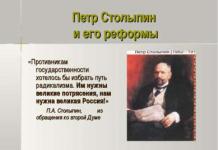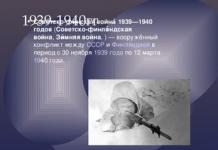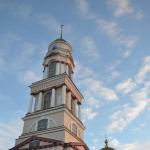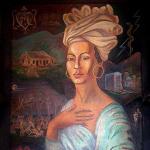Slide captions:
In 1881, Pyotr Arkadyevich, unexpectedly for many, entered the Faculty of Physics and Mathematics of St. Petersburg University, where he studied physics, geology, botany, zoology, and astronomy with interest.
After graduating from the university, Stolypin served in the Ministry of State Property in the modest position of assistant clerk and with the modest rank of collegiate secretary. After 10 years P.A. Stolypin
Kovno
provincial leader of the nobility, and after another 3 years - in 1902, unexpectedly for himself - the governor of Grodno.
P.A. Stolypin did not remain governor of Grodno for long.
In 1902, he was appointed governor of a larger and more important province - Saratov.
Political activity
“We are called to free the people from beggary, from ignorance, from lack of rights”
P. A. Stolypin
Increase s/
X
products
Redemption of land by peasants
Export of wheat (million poods)
YES. Medvedev
“In Russia it is necessary to complete the basic provisions
Stolypinsky
reforms.
Between the times of Stolypin and modern times there is “an invisible connection that today unites us and those who began reforms at the beginning of the 20th century.”
According to D.A. Medvedev, “the main provisions of the reforms of a century ago have yet to be implemented.”
Taming the revolution is his historical merit
He went down in history as one of the greatest political figures
His name was heard at the beginning
XX
century
loudest!
“Thanks to his skillful policy, the country... stepped firmly on the path of development and enrichment” P.A. Stolypin stood “in defense of Rus'” V.V. Rozanov.
“He always went straight to the goal..., never wasted words. If he promised something, he always fulfilled it.” F.A. Golovin.
Assessment of Stolypin by his contemporaries
Goals of agrarian reform
1. To create a strong support for the autocracy in the countryside from strong property owners, splitting them off from the bulk of the peasantry and opposing them to it;
2. To ensure the rise of agriculture and further industrialization of the country in order to eliminate the gap with advanced powers
3. Destroy the community
«
My
father loved farming
..." (Maria Bock)
A hundred years have shown how right he was in defending the idea of Great Russia and rejecting “great upheavals.” A week after his death they began to talk about his oblivion and for a hundred years they have not calmed down. This is the main recognition of his historical personality.
In the sixties, Russia rebelled.
Absorbing the rebellions of those so distant years.
And that's when he appeared
A person so important for Russia was born.
Career began in the Ministry,
Leader of the nobility. Because
He gave his heart to Russia,
I wanted to make my homeland great
.
Stolypin was an ardent opponent of war, if not a completely convinced pacifist. He also believed that riots and uprisings are a deadly poison for Russia. Pyotr Arkadyevich said: “Thirty quiet years and you won’t recognize Russia.”
Pyotr Arkadyevich did not have like-minded people in carrying out reforms.
Stolypinsky
Nikolay stopped supporting the course
II
, because he believed that due to Stolypin’s reforms, the autocracy in the country would come to an end.
“Stolypin was a man of strange fate. He was not eager for power, but unexpectedly for everyone, perhaps even for himself, he found himself at its heights.”
In the last decade, perhaps, no personality has received such attention as the personality of Pyotr Arkadyevich Stolypin. This is largely explained by the fact that in the absence of Soviet stereotypes, society is looking for new idols from the past. In Russia, Stolypin’s native country, debates continue as to whether Pyotr Arkadyevich was a blessing or a disaster for the country.
1 Solution of the land issue;
2 Ensuring personal freedom;
3 Strengthening the principles of religious tolerance and freedom of conscience;
4 Cancellation of administrative expulsion;
5 Introduction of local government.
Stolypin program
6 Transfer of part to self-government
state
. income.
7 Transformation of the police, courts.
8 Reform of labor legislation.
9 Protecting the interests of Russian trade and industry
10 School reform
11 Revival of the army and navy.
“I believe in Russia. If I didn’t have this faith, I wouldn’t be able to do anything.”
P.A. Stolypin
"Us
needed
great
Russia"
Eight decades have shown how right he was in defending the idea of Great Russia and rejecting
«
great upheaval
»
. A week after his death they began to talk about his oblivion and for almost a hundred years they have not calmed down. This is the main recognition of his historical personality.
Stolypin program
The speech on March 6, 1907 played a major role in his political growth. before deputies of the Second State Duma
.
“Thanks to his skillful policy, the country... stepped on solid
foot
on the path of development and enrichment” V.V. Rozanov
PRESENTATION PREPARED BY A 7TH CLASS STUDENT
MKOU "
Avyakskaya
Public school" Znamensky district, Omsk region
Vorobyova Svetlana
Head - history and social studies teacher
Chaunina
Irina Vladimirovna
MKOC "AVYAKSKAYA OOOSH"
Peter
Arkadyevich
Stolypin
HIS NAME
In April 1906
Mr. Stolypin was summoned to Tsarskoe Selo by telegram signed by the emperor. Having met him, Nicholas II said:
that he closely followed the actions in Saratov and, considering them exceptionally outstanding, appointed him Minister of Internal Affairs.
Having survived the revolution and four assassination attempts, Stolypin tried to resign from his position. It is noteworthy that two of his predecessors in this post
-
Sipyagin
and Plehve
-
were killed by revolutionaries. The first Prime Minister of the Russian Empire repeatedly pointed out in his memoirs the fear and reluctance of many officials to occupy responsible positions, fearing assassination attempts.
Witte.
To this the sovereign replied:
-
Pyotr Arkadyevich, I kindly ask you to accept this post.
- Your Majesty, I can’t, it would be against my conscience.
- Then I order you to do this.
My father had no choice but to bow before the will of his sovereign expressed in this form, and he returned to Saratov only for a very short time to hand over the affairs of the province
April 26, 1906
Nicholas II appointed him to the post of Minister of Internal Affairs.
July 8, 1906
P. A. Stolypin was appointed chairman of the Council of Ministers.
“Education of the people, correctly and wisely delivered, will never lead to anarchy”
P. A. Stolypin
Total expenses on education (million rubles)
Expenses on higher education (million rubles)
Expenditures on secondary education (million rubles)
Expenditures on primary education (million rubles)
Reformer Stolypin
Slides: 38 Words: 2670 Sounds: 0 Effects: 0Stolypin. Noble family. Peter's parents. Relationship with the famous poet. Childhood. Places of Stolypin's childhood. Vilna Gymnasium. Oryol gymnasium. Career. Stolypin with the Kovno district leaders of the nobility. Grodno governor. Stolypin with his wife Olga Borisovna. Family. Saratov governor. The village of Pristannoye. Minister of Internal Affairs. Prime Minister. Hunt for the head of government. Military courts. Stolypin reaction. Stolypin tie. Reform program. Stolypin's speech in the State Duma. Idioms. June 3rd coup d'etat. - Reformer Stolypin.ppt
Stolypin Pyotr Arkadevich
Slides: 23 Words: 1985 Sounds: 0 Effects: 0Stolypin Petr Arkadevich. Statesman of the Russian Empire. On June 3, 1881, 19-year-old Peter graduated from the Oryol gymnasium. Orders. Minister of Internal Affairs. The Minister of Internal Affairs was the first among other ministers. After taking the post of Prime Minister, Stolypin combined both posts. You can’t tell the sentry: you have an old flintlock gun. Reforms of Pyotr Arkadyevich. Agrarian reform. Economic situation of the Russian peasantry. The situation was well known to Stolypin. The reform unfolded in several directions. Siberian politics. Stolypin's policy regarding Siberia. - Stolypin Pyotr Arkadyevich.pptx
Stolypin's politics
Slides: 14 Words: 748 Sounds: 0 Effects: 0Pyotr Arkadyevich Stolypin. Study of the activities of P.A. Stolypin. Biography. Biography of P.A. Stolypin. Family. Governor of the Saratov province. Activities in Saratov. As a minister. Great upheaval. Agrarian reform. Petitions to secure land. Local government reform. Results of government activities. Resources used. - Stolypin's Politics.ppt
Stolypin's reforms
Slides: 31 Words: 1825 Sounds: 0 Effects: 0Reformer of the Russian Empire. 150 years since the birth of Pyotr Arkadyevich Stolypin. The significance of government activities. Pyotr Arkadyevich Stolypin. Achieving universal literacy. Compulsory initial free training. Study trips abroad. Personality P.A. Stolypin. Pyotr Arkadyevich Stolypin. A set of documents and materials. Life path and government activities. Increased attention to Stolypin's personality. The last reformer. An attempt at a comprehensive analysis of the Stolypin concept. The reforms still generate great interest today. Phenomena of the Russian genius. Reformer. - Stolypin's reforms.ppt
Stolypin's activities
Slides: 24 Words: 1630 Sounds: 0 Effects: 88Pyotr Arkadyevich Stolypin. P.A. Stolypin. The purpose of the lesson. Lesson plan. The name of Russia. Stolypin belonged to an old noble family. Problem task. Reforms. What was the Minister of Internal Affairs responsible for in 1906? Government program. The idea of introducing military courts. Stolypin's activities. Agrarian reform by P.A. Stolypin. Features of agrarian reform. Cut Agrarian reform. Stolypin's activities. Stolypin's activities. Reasons for failure. The beginning of disagreements. A hundred years have shown how right he was. Statements by D.A. Medvedev. Homework. List of used literature. - Stolypin’s activities.ppt
Agrarian reform of P.A. Stolypin
Slides: 33 Words: 1844 Sounds: 0 Effects: 68Evil demon of the Russian Empire. Dates and events. P.A. Stolypin. Stolypin's dacha after the explosion. Proceedings on “revolutionary cases”. The State Duma. Electoral law. Transformations. Desired and actual. Goals of agrarian reform. Half-starved village. "Calming" the country. The power of Russia. Creation of social and economic support. The main wealth and power of the state. Continued modernization of Russia. Creation of "Great Russia". Agrarian reform P.A. Stolypin. Main events. Reform. Peasant. Number of immigrants. Community. Obstacles. Stolypin did not expect quick results. - Agrarian reform by P.A. Stolypin.pptx
Stolypin's agrarian reform briefly
Slides: 14 Words: 594 Sounds: 0 Effects: 2Stolypin's agrarian reform and Russian society. P.A. Stolypin. Reveal the essence of agrarian reform. I believe in Russia. Rapid economic development of Russia. The main directions of P. Stolypin’s reform activities. Russia. Representatives of the upper class. Agrarian reform and its goals. Main goals. Resettlement policy. Positive and negative features of the reform. Results of agrarian reform. Pyotr Arkadyevich Stolypin. - Stolypin’s agrarian reform briefly.ppt
Stolypin's economic reforms
Slides: 16 Words: 991 Sounds: 0 Effects: 0Pyotr Arkadyevich Stolypin. Russia at the beginning of the twentieth century. Biographical information. Stolypin's career. Stolypin's activities. The fight against the revolution. Agrarian reform. Growth in agricultural production. Socio-economic reforms. Work question. National question. Why no one supported Stolypin. Assassination attempts on the reformer. Death of Stolypin. Results of reforms. Stolypin's ideas. -
1 slide
presentation on the history of Russia Pyotr Arkadyevich Stolypin and his reforms 11th grade was completed by: history teacher of the highest category V.V. Putilovskaya.

2 slide
Peter Stolypin and his reforms “Opponents of statehood would like to choose the path of radicalism. They need great upheavals, we need a great Russia!” P.A. Stolypin, from an address to the Second Duma

3 slide
Pyotr Arkadyevich Stolypin. 1862 - 1911 The last major statesman of Tsarist Russia Belonged to an old noble family, which gave Russia many diplomats, military men, and statesmen Second cousin of the poet M.Yu. Lermontov His father was a participant in the Crimean and Russian-Turkish war of 1877-1878. - rose to the rank of general

4 slide
Disciple of Mendeleev Although “My hope is in God” was carved on the Stolypin family coat of arms, Pyotr Arkadyevich relied more on his own strengths and abilities

5 slide
The path to the top 1884 - graduated from the natural sciences department of the Faculty of Physics and Mathematics of St. Petersburg University and entered the service in the Ministry of Internal Affairs 1886 - transferred to serve in the Ministry of State Property, rising to the position of assistant chief 1889 - returned to the Ministry of Internal Affairs (appointed Kovno district marshal of the nobility and chairman of the local Congress of World Mediators)

6 slide
The path to the top 1899 - appointed leader of the nobility of the Kovno province 1902 - received the post of governor of Grodno 1903 - appointed governor of Saratov April 26, 1906 - appointed to the post of Minister of Internal Affairs July 8, 1906 - appointed chairman of the Council of Ministers while retaining the post of head of the Ministry of Internal Affairs

7 slide
Russia's choice of path in 1906 You'll go straight... You'll go right... You'll go left... Revolution Counter-revolution Reforms

8 slide
“First calm, then reforms” P.A. Stolypin August 12, 1906 - the first attempt on P.A. Stolypin August 19 - in an emergency order, according to Article 87, a decree on military courts was adopted (combatant officers were appointed to their composition, who were supposed to decide cases of “rebels” according to martial law in no more than 48 hours, and sentences carry out execution within 24 hours), which was in effect until April 20, 1907. In eight months, military courts handed down about 1,100 death sentences. But... Stolypin sought not only to suppress the revolution through repression, but also through reforms in ways pleasing to the government and ruling circles spirit

Slide 9

10 slide
Decree of November 9, 1906 Laid the beginning and allowed Stolypin's free exit of the agrarian reform of peasants from the community

11 slide
Stolypin agrarian reform (1906 - 1911) Reform of allotment peasant land ownership The goal is to create a class of land owners as a social support of the autocracy and an opponent of revolutionary movements

12 slide
“Give the state 20 years of internal and external peace, and you will not recognize today’s Russia” P.A. Stolypin

Slide 13

Slide 14
The agrarian question in the programs of political parties Political forces Projects for solving the agrarian question 1 Bolsheviks 1 Municipalization of land 2 Mensheviks 2 National lands after their forcible seizure from landowners 3 Social Revolutionaries 3 Use of state, appanage, monastic lands; forced alienation of part of the landowners' lands for ransom 4 Cadets 4 Sale of state and appanage lands to peasants 5 Octobrists 5 Socialization of lands

15 slide
Main directions of agrarian reform Destruction of the community. Peasants are private owners of their plot of land Khutor, Otrub

16 slide
Cooperation is a form of organization of labor and production based on group ownership of cooperative members

Slide 17
A farm is a rural settlement, most often consisting of one yard; isolated peasant estate located outside the community

18 slide
A cut is a plot of land allocated to a peasant in return for the communal lands previously allocated to him, located in different places. The estate remained within the village

Slide 19
Components of the agrarian reform Destruction of the peasant community - permission for peasants to leave the community with the right to secure private ownership of their land plots in the form of a farm or cut - For 1907-1914. 2.5 million peasants were separated from the community (22% of all peasant farms) - the creation of farms justified itself only in some western provinces, and cuts - in the provinces of the Northern Black Sea region, the North Caucasus and the steppe Trans-Volga region

20 slide
In 1906-1916. 3.1 million people left for Siberia (loans for immigrants, free travel) 548 thousand people returned to their former places, i.e. every fifth Resettlement policy - organization of the resettlement movement to Western Siberia with the aim of providing landless and land-poor peasants with land

21 slides
Credit policy - Transfer of state-owned lands to the Peasant Bank for sale to needy peasants - The Bank sold state-owned lands to peasants on credit - Benefits were provided to owners of farms and cuts

22 slide
Social policy in the countryside Widespread construction of rural schools and the involvement of huge masses of the population in the public education system

Slide 23
Reasons for the incompleteness of the reform Short time period Resistance from the right and left political forces Complex relationships between the tsar’s entourage and P.A. Stolypin Murder of P.A. Stolypin - September 1, 1911

24 slide
Results and significance of the agrarian reform + - 1. Increase in agricultural production and improvement of land management (grain harvest increased 1.7 times). 2. The growth of free labor due to the exit of poor peasants from the community. 3. Development of entrepreneurship of the rural bourgeoisie. 4. The beginning of the formation of farms (by 1915, 10% of the peasant economy). 1. The community was not destroyed (25% of peasants). 2. Property stratification of peasants. 3. Negative attitude of the majority of peasants towards private property. 4. Contradiction not only between peasants and landowners, but also within the peasantry. 5. It was not possible to create a broad layer of peasant farmers. 6. The problem of land shortage has not been solved. 7. The resettlement policy did not bring the desired results (0.5 - 1 million people returned).

25 slide
Agrarian reform by P. A. Stolypin Goals of the reform Activities Results Significance of the reform “Calm” of the country. Creation of a layer of land owners - the social and economic support of the monarchy. Continuation of the modernization process. Creation of new forms of land ownership and land use. State assistance to peasant farms. Development of peasant cooperation. Resettlement policy. The beginning of the creation of farms, the growth of sown areas, the improvement of agricultural technology, the rise in labor productivity in agriculture, the development of production cooperatives. But the problems of peasants' dairy farming persist, and new social contradictions appear. Despite the obvious difficulties and incompleteness of the reforms, the reform contributed to the country's development along the path of modernization.
History lesson in 11th grade.
Topic: “P.A. Stolypin: the fate of a reformer in Russia.”
Lesson objectives:
- promote the development of a sense of patriotism, morality, and involvement in the history of the Fatherland;
- consider the main directions of P.A. Stolypin’s reform course, identify the essence and significance of his activities;
- continue to develop skills in working with a historical document, assessing a historical figure.
Lesson form: combined with presentation elements.
Equipment: multimedia projector, interactive whiteboard.
Epigraph: “Opponents of statehood...need great upheavals, we need a great Russia.” From the speech of P.A. Stolypin in the State Duma on May 10, 1907.
Lesson plan.
4. Assassination attempts.
During the classes:
- New material.
1. The state of the agrarian question in Russia.
The agrarian question is the most acute in Russia at the beginning of the twentieth century.
(- Peasants made up the majority of the population of Russia).
a) Characteristic features of the development of agriculture in Russia at the beginning of the twentieth century:
Preservation of landownership;
Redemption payments;
Preservation of the peasant community;
Low culture of land ownership (extensive path).
b) The community played a special role in the life of the Russian peasantry.
Individual student message.
Since the times of Kievan Rus, the main institution of rural life has been the community, universal and inviolable for both its members and state authorities. She was considered sacred like earth and water, and therefore only God was higher than her. The community (or the world, as the community members themselves called it) was the “alpha” and “omega” of the earthly life of the peasant, and in Russia the overwhelming majority of people were peasants.
In 1861, serfdom fell, but the community remained, and with it all the institutions of the Russian Middle Ages related to the community and communal land ownership and land use remained intact.
The main principle of land relations in the community was the complete absence of private ownership of land, when the land was declared God's and belonged not to any individual or family, but to the entire community. The land could neither be sold, nor exchanged, nor be the subject of collateral or any other transactions.
Thus, the Russian peasant worked on the land for hundreds of years, but was never its owner; used it, but did not have it, although others - the true owners of the land - could do whatever they wanted with the land they owned: buy, sell, give, exchange...
c) Individual message.
We see that Russia followed the “Prussian” path of development. This is a slow path with the preservation of feudal remnants. Our country combined developed industry and backward agriculture. The first Russian revolution of 1905-1907 showed that if the agrarian question is not resolved, a new revolutionary explosion will occur. “A wild, half-starved village will always represent combustible material.”
In 1906, Pyotr Arkadyevich Stolypin, one of the outstanding reformers of Russia, who developed a program for reforming the country, was appointed head of the government. The identity of this man has been the subject of much controversy. Both his contemporaries and his descendants expressed the most contradictory opinions about him and his activities. “The period of the Stolypin reaction”, “Stolypin’s ties”, on the one hand, and “a fighter for the good of Russia, a man worthy to sit on the royal throne” - on the other. Stolypin's career did not last long, but it was a time of grandiose plans for the reconstruction of Russia.
QUOTE . “A wild, half-starved village will always represent combustible material.”
2. Personality characteristics of P.A. Stolypin.
a) Individual message.
“Pyotr Arkadyevich Stolypin, the son of the Sevastopol hero, Adjutant General Stolypin from his marriage to Princess Gorchakova, was born in 1862 and spent his childhood on the Srednikovo estate near Moscow. After completing a course at St. Petersburg University in 1884, he began his career in the Ministry of Internal Affairs, two years later he was assigned to the Department of Agriculture and Rural Industry of the Ministry of Agriculture and State Property, in which he successively held various positions and was especially interested in agriculture and land management. Then he moved to the Ministry of Internal Affairs as the Kovno district leader of the nobility and chairman of the Kovno Congress of World Mediators...
In 1902, Stolypin was entrusted with correcting the post of governor of Grodno, and a year later he was appointed governor of Saratov.
He had to spend the beginning of the revolutionary unrest in Saratov and take decisive measures against revolutionary propaganda and, especially, to stop the unrest in the Balashov district. In Saratov, he took an active part in the activities of local charitable institutions. The local department of trusteeship of the Empress Maria Feodorovna for the deaf and dumb elected him to its honorary members...”
When in 1906 the Council of Ministers headed by Count S.Yu. Witte retired and I.L. Goremykin was entrusted with forming a new Council of Ministers, Stolypin was offered the post of Minister of Internal Affairs. From that time - April 26, 1906 - P.A. Stolypin until the day of his death was an active leader of the ministry.
After the dissolution of the First State Duma, he was ordered to be Chairman of the Council of Ministers on July 8, 1906... Having become the head of the Council of Ministers, Stolypin managed to breathe unanimity into the activities of the Council, return the shaken prestige to state power and strengthen it. The revolutionary terrorist parties could not come to terms with the appointment of a staunch nationalist and supporter of strong government to the post of prime minister.”
QUOTE. “Give the state 20 years of internal and external peace, and you will not recognize today’s Russia.”
3. Reform activities of P.A. Stolypin.
a) Reform in the field of education, science and culture.
Personal message.
Reforms in the field of education, science and culture.
Systemic modernization of the country without introducing knowledge to the majority of the population was impossible. One of the most important areas of P.A. Stolypin’s reforms is improving the education system. The Ministry of Public Education developed a bill “On the introduction of universal primary education in the Russian Empire,” according to which it was supposed to provide children of both sexes with an elementary education. The government was developing measures aimed at creating a unified system of educational institutions. The state spared no expense on schools and teacher training. During the period of the Stolypin reforms, allocations for the needs of primary education increased almost fourfold: from 9 million to 35.5 million rubles.
During the years of reform, the government actively financed fundamental research, scientific expeditions, academic publications, restoration work, theater groups, and the development of cinema...
b) Agrarian reform.
Agrarian reform is the main reform in the life of P.A. Stolypin.
Personal message.
Agrarian reform.
The agrarian reform of P.A. Stolypin had two goals: short-term and long-term. The short-term goal of the reform was the resolution of the “agrarian question” as a source of mass discontent (first of all, the end of peasant uprisings, the calming of the country), the long-term goal was the sustainable prosperity and development of agriculture and the peasantry, the integration of the peasantry into the market economy, the transformation of a layer of wealthy peasants into a social support .
On November 9, 1906, the main legislative act of the reform was issued - the decree “On supplementing some provisions of the current law relating to peasant land ownership and land use.” The decree proclaimed the right of peasants to secure ownership of their allotment lands: “every householder who owns land on a communal basis can at any time demand that the portion of the said land due to him be secured as his personal property.”
An important part of the agrarian reform was the encouragement of the purchase of privately owned (primarily landowner) lands by peasants. The Peasant Land Bank issued loans to peasants for the purchase of land. Stolypin’s policy regarding Siberia consisted of encouraging the resettlement of peasants from the European part of Russia to its uninhabited expanses. About 3 million people moved to Siberia. In the Altai Territory alone, 3,415 settlements were founded, where over 600 thousand peasants from the European part of Russia settled.
The peasants were given 500 rubles of an interest-free loan, cheap railway tickets, the peasants were provided with good carriages with space for transporting livestock, were exempt from taxes for 5 years, and were completely exempted from military service.
c) Objectives of agrarian reform:
1.Transfer agriculture to a capitalist mode.
2.Create a strong base of strong owners in the village.
3.Destroy the community.
4.Reduce social tension.
d) 2 goals of the reform:
Elimination of the revolutionary center in the village.
Development and prosperity of agriculture and peasantry.
QUOTE. “The government wants to increase peasant land ownership. It wants to see the peasantry rich and prosperous. Because where there is prosperity, there is enlightenment and freedom. The wealth of the people creates the power of the country.”
e) The essence of agrarian reform.
Personal message.
1. The right of peasants to leave the community and to secure the allotment as personal property.
2. Allocation of cuts to the peasants. A cut is a piece of land in one place - without stripes - received by a peasant leaving the community. Interstriped - the arrangement of land plots (strips) of one farm interspersed with strips located in the possession of another farm. This made it difficult to use agricultural machinery.
3.Transition of a number of peasants to farmsteads. A farmstead is a single-yard rural settlement.
4. Resettlement policy - voluntary resettlement of peasants to state-owned lands and sparsely populated areas of the Urals and Siberia.
5. Widespread construction of rural schools and the involvement of huge masses of the population in the public education system.
6.Equalization of peasants with other classes.
d) The transformations were difficult - encountering resistance from various layers of society. The reform was criticized by everyone...left parties, right parties, bureaucracy...
Here is a fragment of correspondence between P.A. Stolypin and L.N. Tolstoy.
L.N. Tolstoy:
“What is needed now to calm the people is not measures that would increase the amount of land of these or other Russian people called peasants (as they usually look at this matter), but it is necessary to destroy the age-old, ancient injustice...
The injustice lies in the fact that just as the right of one person to own another (slavery) cannot exist, so there cannot be the right of any one person, rich or poor, king or peasant, to own land as property... Land is the property of all , and all people have the same right to enjoy it."
P.A. Stolypin:
“You consider evil what I consider good for Russia. It seems to me that the lack of land ownership among peasants creates all our disorder.
Nature has invested in man some innate instincts..., and one of the strongest feelings of this order is the sense of ownership. You cannot love someone else’s property on an equal basis with your own, and you cannot cultivate and improve land that is in temporary use, on an equal basis with your own land.
The artificial castration of our peasant in this regard, the destruction of his innate sense of property, leads to many bad things, and, most importantly, to poverty. And poverty, for me, is the worst of slavery...
It's funny to talk to these people about freedom or liberties. First, bring their level of well-being to at least the minimum level where the minimum contentment makes a person free...
I was carried to the top by a wave of events - probably for an instant! I still want to use this moment to the best of my strength, understanding and feelings for the benefit of people and my homeland, which I love, as they loved it in the old days. How can I do something that is not what I think and recognize as good?.. Believe me, when I often feel the possibility of imminent death, I cannot help but think about these questions, and my path seems to me to be the straight path...
QUOTE. “As long as the peasant is poor, as long as he does not have minimal land ownership, he remains a slave, and no written law gives him the benefit of civil freedom.”
e) Results of agrarian reform.
Personal message.
Stolypin's agrarian reform turned out to be the most consistent and most decisive in the entire existence of Russia.
- During the reform, 4 million dessiatines of land were involved in market circulation.
- At least 23% of peasant farms were allocated to communities, and about 1.5 million were allocated to farms and farms.
- 3 million households were resettled from the central regions of European Russia, and 0.5 million returned after some time. About 3 million people moved to Siberia. In the Altai Territory alone, during the ongoing reforms, 3,415 settlements were founded, in which over 600 thousand peasants settled.
- The stratification of the peasantry intensified; the rural elite provided half of the marketable grain.
- During the period from 1908 to 1909, the consumption of superphosphate fertilizers increased from 8 to 20 million poods.
- For 1900-1913 per capita income increased from 22 to 33 rubles. in year.
- The discontent of the poor and the number of arson attacks on farms and farmsteads increased.
4. Assassination attempts.
a) Individual message.
Attempts on Stolypin.
Stolypin's reforms, and primarily the agrarian reform, are very important for the history of Russia. Pyotr Arkadyevich Stolypin was against wars and revolutions, he said: “Give the State 20 years of peace, internal and external, and you will not recognize today’s Russia.” And Kaiser Wilhelm of Germany told Adjutant General I.L. Tatishchev that “if he had a minister like Stolypin, then Germany would rise to the greatest heights.”
Representatives of terrorist organizations, wanting not peace, but “great upheaval,” launched a real “hunt” for the prime minister, preparing more than 10 assassination attempts. On August 12, 1906, another attempt was made on P.A. Stolypin, accompanied by a large number of victims. The terrorist attack took place in a mansion on Aptekarsky Island in St. Petersburg. “The explosion was very powerful. The rooms on the first floor and the entrance were destroyed, and the upper rooms collapsed.” More than 60 people were injured (27 were killed), including women and children. The prime minister's son and daughter, Arkady and Natalya, were seriously injured.
According to the formula of the historian S.M. Solovyov, in Russia the relationship between the individual and the state passed through sacrifice. And Pyotr Arkadyevich Stolypin clearly understood that on the path to saving Russia he would be sacrificed. Therefore, in the first lines of his will he wrote: “I want to be buried where they kill me.”
The last assassination attempt, committed by the terrorist D. Bogrov at the Kiev Opera House on September 1, 1911, was fatal. Stolypin's death, which followed on September 5, interrupted the peaceful evolutionary process of reforming the country that had begun, which had tragic consequences for its subsequent history.
Pyotr Arkadyevich Stolypin was buried, as he asked in his will, “where they will kill” - in Kyiv - in the Kiev-Pechersk Lavra.
b) Individual message.
The obituary written by the editor of the newspaper “Novoye Vremya” A.S. Suvorin shortly after the murder of Stolypin said the following: “An enlightened politician, economist and lawyer, a major administrative talent, he almost abandoned his personal life and his amazing ability to work, not familiar with fatigue , invested in the cause of state calm and construction... Having fallen ill with lobar pneumonia in the spring of 1909, he agreed to leave St. Petersburg only at the insistent demands of doctors... He was always a brilliant speaker, spoke with inspiration, concisely and efficiently, developing masterfully and vividly the guidelines of the bill or giving an answer and clarification on various types of requests for government action. P.A. Stolypin's state merits were recognized in a short time with a number of royal awards. As a person, Stolypin was distinguished by his straightforwardness, sincerity and selfless devotion. He was free from pride and arrogance thanks to the rare qualities of his exceptionally balanced nature. He always treated other people's opinions with attention and respect. To your subordinates and their needs. An enemy of all ambiguities, suspicions and hypotheses, he shunned intrigue and intrigue, and petty politics. In his political views, P.A. Stolypin did not depend on any party pressures or claims. Firmness, perseverance, resourcefulness and high patriotism were inherent in his honest, open nature. Stolypin especially did not tolerate lies, theft, bribery and self-interest, he persecuted them mercilessly..."
- Consolidation of the studied material.
Do you think the reform achieved its goals?
What would happen to Russia if it received, as Stolypin dreamed, “20 years of internal and external peace?”
What, in your opinion, is Stolypin’s patriotism?
- Summarizing. Lesson conclusions.
This is Stolypin's patriotism.
P.A. Stolypin is an island of decency and patriotism in the ocean of decay and negativity that reigned in Russia at the beginning of the twentieth century.
Due to the rarity with which statesmen of such caliber are encountered, it is difficult, almost impossible for us to comprehend the full magnitude that Pyotr Arkadyevich represented.
Stolypin combined state interests and concern for people - almost incompatible things...
Stolypin Pyotr Arkadyevich () Biography
Pyotr Arkadyevich came from a noble family that already existed in the 16th century. The founder of the Stolypins was Grigory Stolypin. One of the five sisters of grandfather Pyotr Stolypin married Mikhail Vasilyevich Arsenyev. Their daughter Maria became the mother of the great Russian poet, playwright and prose writer M. Yu. Lermontov. Thus, Pyotr Arkadyevich was Lermontov’s second cousin. Family coat of arms of the Stolypins


Peter Arkadyevich's father is Arkady Dmitrievich, an active participant in the defense of Sevastopol, during the Russian-Turkish War, Governor-General of Eastern Rumelia, later commanded the Grenadier Corps in Moscow, then commandant of the Kremlin Palace. Mother, Natalya Mikhailovna Stolypina (née Gorchakova), daughter of Chancellor Prince M.D. Gorchakov.


When the time came to enroll the children in the gymnasium, Arkady Dmitrievich bought a house in neighboring Vilna. The two-story house with a large garden was located on Stefanovskaya Street (now Shvento Styapono Street). In 1874, 12-year-old Peter was enrolled in the second grade of the Vilna Gymnasium, where he studied until the sixth grade. Student of the Vilna gymnasium P. A. Stolypin year

In September 1879, the 9th Army Corps under the command of his father was returned from Bulgaria to the city of Orel. Peter and his brother Alexander were transferred to the Oryol men's gymnasium. Peter was enrolled in the seventh grade. According to B. Fedorov, he “stood out among high school students for his prudence and character.”

On June 3, 1881, 19-year-old Peter graduated from the Oryol gymnasium and received a matriculation certificate. He left for St. Petersburg, where on August 31 he entered the natural sciences department of the Faculty of Physics and Mathematics of the St. Petersburg Imperial University. St. Petersburg University at the beginning of the 19th century


Stolypin's marriage was associated with tragic circumstances. The elder brother Mikhail died in a duel with Prince Shakhovsky. Mikhail was engaged to the maid of honor of Empress Maria Feodorovna Olga Borisovna Neidgardt, who was the great-great-granddaughter of the great Russian commander Alexander Suvorov. There is a legend that on his deathbed, Peter's brother placed Peter's hand on the hand of his bride. After some time, Stolypin asked Olga Borisovna’s father for her hand in marriage, pointing out his shortcoming “youth.” The future father-in-law smiled and replied that “youth is a defect that is corrected every day.” The marriage turned out to be very successful. The Stolypin couple had five daughters and one son. P.A. Stolypin with his wife and children

In October 1885, the council of the Imperial St. Petersburg University “approved Stolypin as a candidate of the Faculty of Physics and Mathematics,” which corresponded to receiving an academic degree and completing university education. In 1886, he was approved with the rank of collegiate secretary (which corresponded to class X of the table of ranks); in January 1887 he became assistant chief (VII class) of the Department of Agriculture and Rural Industry. On January 1, 1888, Stolypin was “granted the rank of chamber cadet of the Court of His Imperial Majesty” (V class). Thus, in just two years he climbed five steps up the ladder of ranks of the bureaucratic system of the Russian Empire.

However, Stolypin soon returned to serve in the Ministry of Internal Affairs. On March 18, 1889, he was appointed Kovno district marshal of the nobility and chairman of the Kovno Court of Peace Mediators. Stolypin spent about 13 years in service in Kovno from 1889 to 1902.

Since 1902, P.A. Stolypin was appointed to the post of Governor of Grodno. In 1903 he was transferred to the post of Saratov governor. In April 1906, P.A. Stolypin was appointed Minister of Internal Affairs, and on July 8 - Chairman of the Council of Ministers.

As Prime Minister, Stolypin acted very energetically. He was remembered as a brilliant orator, many phrases from whose speeches became catchphrases, a man who coped with the revolution, a reformer, a fearless man on whom several attempts were made on his life. Stolypin remained in the position of Prime Minister until his death, which followed an assassination attempt in September 1911. P. A. Stolypin. Portrait by I. Repin (1910)

Stolypin with his family at the Kėdainiai Church of the Transfiguration after the festive service for the Dormition of the Blessed Virgin Mary. August 15 (old style) 1911, the last lifetime photograph of P.A. Stolypin on Lithuanian soil. In just two weeks, a fatal shot will be fired in the Kiev theater, killing the Russian Prime Minister...





















